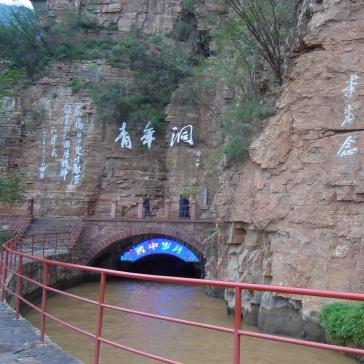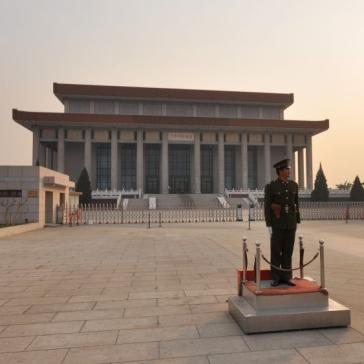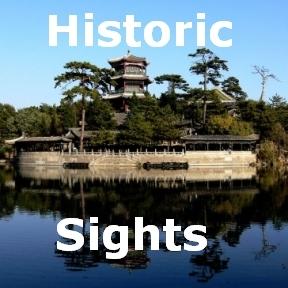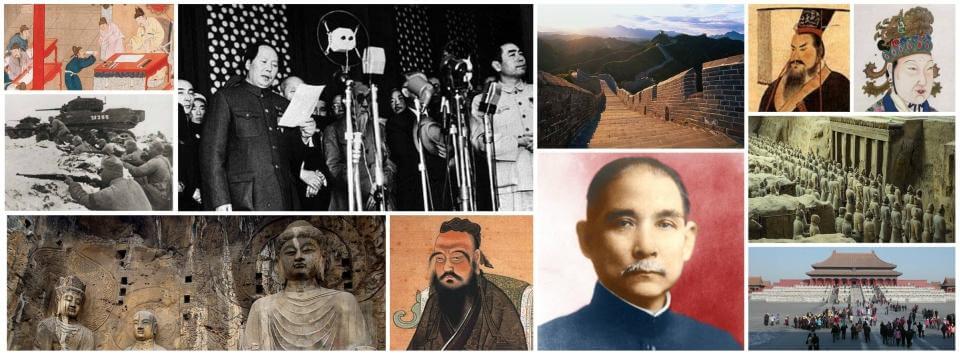
People's Republic of China (since 1949)
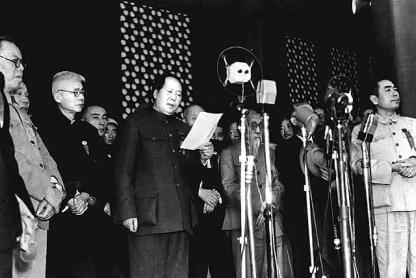 Mao Zedong declaring the founding of the People's Republic of China (PRC) on the 1st of October 1949On the 1st of October 1949, Mao Zedong proclaimed the founding of the People's Republic of China (PRC) in a rousing speech (famous quote: "The Chinese people have stood up.") from atop the Tiananmen Gate (eng. "Gate of Heavenly Peace"). An estimated 300,000 people had assembled to witness this historic event on the adjoining Tiananmen Square. The Communist Party of China (CPC) portrayed the founding of the People's Republic as the culmination of the Chinese people's struggle for a better future that had started with the overthrow of the imperial regime in 1911/12.
Mao Zedong declaring the founding of the People's Republic of China (PRC) on the 1st of October 1949On the 1st of October 1949, Mao Zedong proclaimed the founding of the People's Republic of China (PRC) in a rousing speech (famous quote: "The Chinese people have stood up.") from atop the Tiananmen Gate (eng. "Gate of Heavenly Peace"). An estimated 300,000 people had assembled to witness this historic event on the adjoining Tiananmen Square. The Communist Party of China (CPC) portrayed the founding of the People's Republic as the culmination of the Chinese people's struggle for a better future that had started with the overthrow of the imperial regime in 1911/12.
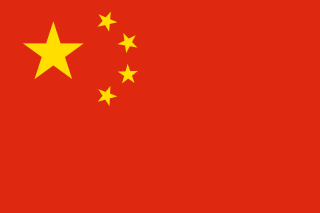 Flag of the People's Republic of ChinaAfter the founding of the People's Republic of China, the communist government embarked upon an ambitious program to build a new China. The process of land reform that had already begun in 1948 in communist-controlled northern Chinese areas was the program's core. The communists drew upon their earlier-made experiences with land reform at the Jiangxi Soviet in their efforts to distribute land in a more equitable way.
Flag of the People's Republic of ChinaAfter the founding of the People's Republic of China, the communist government embarked upon an ambitious program to build a new China. The process of land reform that had already begun in 1948 in communist-controlled northern Chinese areas was the program's core. The communists drew upon their earlier-made experiences with land reform at the Jiangxi Soviet in their efforts to distribute land in a more equitable way.
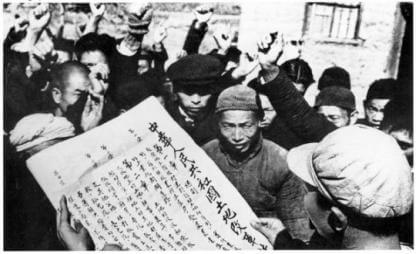 A man reads the Land Reform Law of the People's Republic of China in 1950The process of land reform extended well into the 1950s, especially in the south and southwest of China. It was a time-consuming process that was facilitated by communist work teams that were sent to all the villages.
A man reads the Land Reform Law of the People's Republic of China in 1950The process of land reform extended well into the 1950s, especially in the south and southwest of China. It was a time-consuming process that was facilitated by communist work teams that were sent to all the villages.
During a week/month-long preparatory phase, these facilitators collaborated with politically motivated sympathizers in the villages, listening to grievances of the peasants, establishing who the land owners were, determining the power relationships within the village etc. before moving on to the stage of implementation. That stage often violently transformed the agricultural system of ownership. Mass assemblies of the village peasantry were organized in which landlords were denounced, had their land titles and deeds seized and were often beaten and sometimes even killed.
Despite its cruelties, the process of land reform was essential for breaking up the political power of the old rural elites, creating the material conditions for modern modes of agricultural production (which had hardly changed since the 17th century) and being able to reward peasants for their support of the communist party.
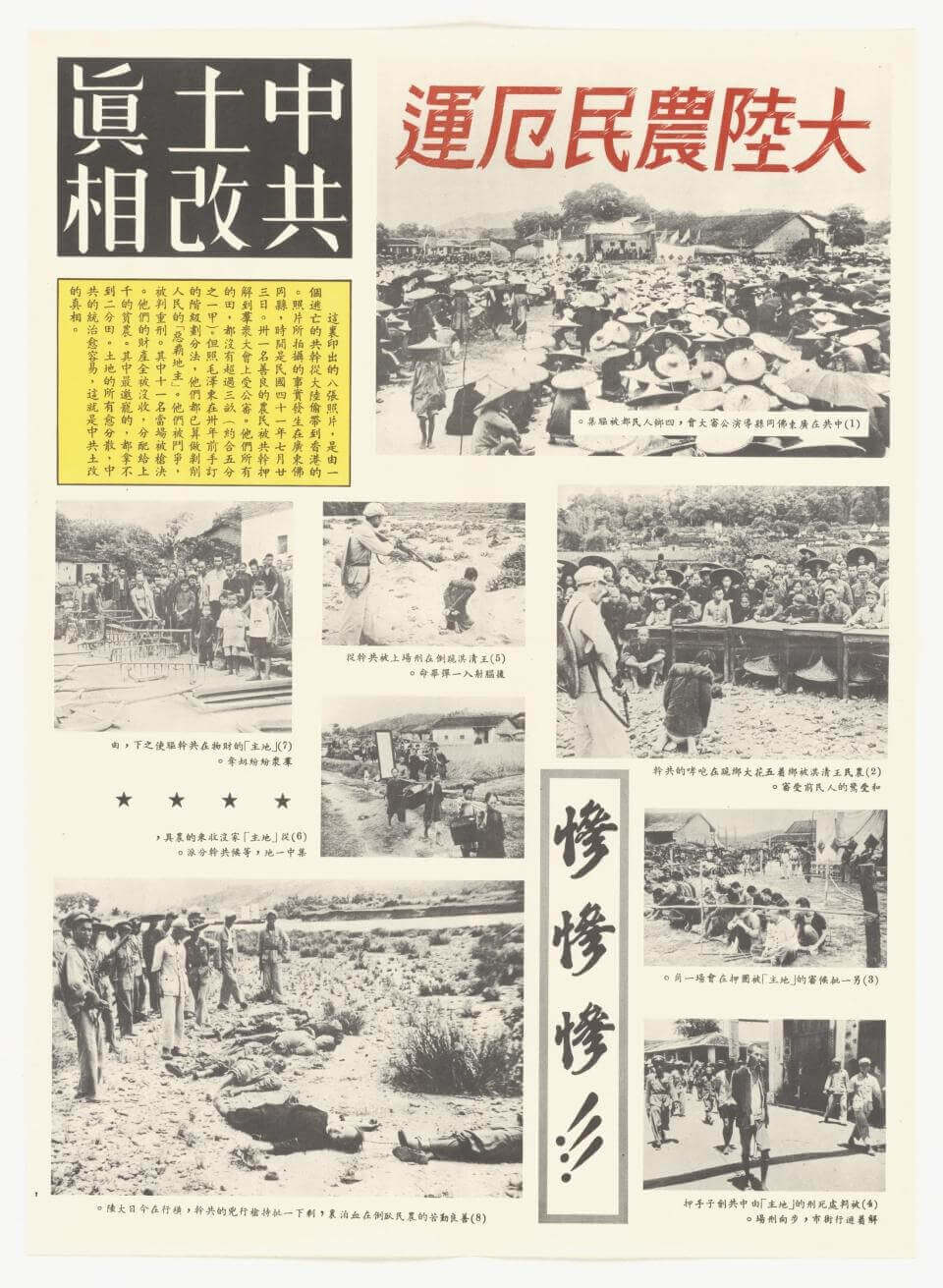 A newspaper (possibly from Taiwan or Hong Kong) page entitled "Real Story of Red China Land Reform"
A newspaper (possibly from Taiwan or Hong Kong) page entitled "Real Story of Red China Land Reform"
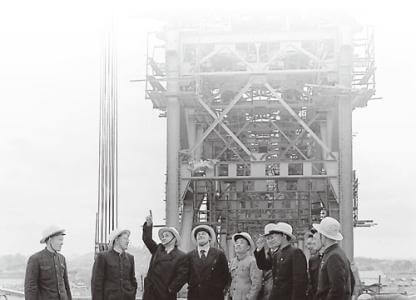 Chinese and Soviet engineers at the Wuhan Yangtze River Bridge in 1957While the process of land reform was carried out across China, other reforms sought to transform China's traditional rural Confucian culture. The new marriage law was meant to abolish arranged marriage and allow people to freely choose their life partner. Divorce was legalized and could henceforth be initiated by both men and women. Redistributed land was no longer given to the head of the household but to both men and women. These radical reforms that dramatically transformed the core values and structure of society empowered women and set the right conditions for China's future development.
Chinese and Soviet engineers at the Wuhan Yangtze River Bridge in 1957While the process of land reform was carried out across China, other reforms sought to transform China's traditional rural Confucian culture. The new marriage law was meant to abolish arranged marriage and allow people to freely choose their life partner. Divorce was legalized and could henceforth be initiated by both men and women. Redistributed land was no longer given to the head of the household but to both men and women. These radical reforms that dramatically transformed the core values and structure of society empowered women and set the right conditions for China's future development.
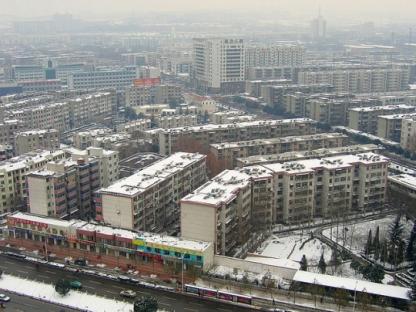 typical rows of apartment buildings in China, here in the city of Luoyang in Henan provinceWhereas land reform benefited the sector of agriculture, the Chinese industrial economy was jumpstarted again with the assistance of Soviet advisors in the 1950s under the terms of a new alliance between China and the Soviet Union. Besides modernizing the industrial sector, China started a program of socialist construction that upgraded its real-estate sector.
typical rows of apartment buildings in China, here in the city of Luoyang in Henan provinceWhereas land reform benefited the sector of agriculture, the Chinese industrial economy was jumpstarted again with the assistance of Soviet advisors in the 1950s under the terms of a new alliance between China and the Soviet Union. Besides modernizing the industrial sector, China started a program of socialist construction that upgraded its real-estate sector.
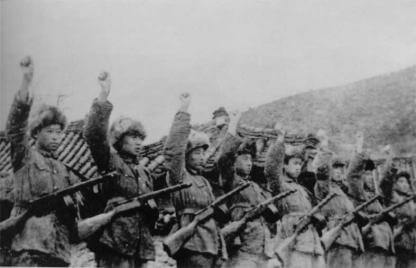 Chinese soldiers during the Korean WarThe Korean War between the North and the South threatened to bring American troops into China again, but the massive Chinese intervention in the autumn of 1950 kept the Chinese homeland secure though arguably prolonging the war (which is technically still ongoing since the two Koreas never signed a peace treaty!).
Chinese soldiers during the Korean WarThe Korean War between the North and the South threatened to bring American troops into China again, but the massive Chinese intervention in the autumn of 1950 kept the Chinese homeland secure though arguably prolonging the war (which is technically still ongoing since the two Koreas never signed a peace treaty!).
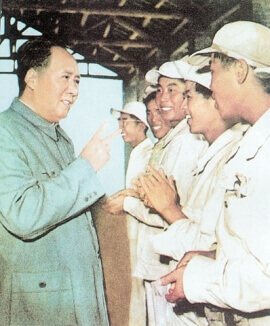 photo of Mao Zedong with workersMao Zedong was the leader of the new socialist China from 1949 until his death in 1976. His vision of building a modern industrialized nation that he expressed in his speeches and writings was officially in line with the objectives of the Communist Party of China. However, even though China's objectives were nearly universally agreed upon in leadership circles, discussions about the different possible ways of getting there occasionally led to conflict within the leadership. These debates were generally kept within the leadership of the CPC, but sometimes they were fought out openly. One such contentious issue that led to conflict within different party groups in the 1950s was agricultural policy.
photo of Mao Zedong with workersMao Zedong was the leader of the new socialist China from 1949 until his death in 1976. His vision of building a modern industrialized nation that he expressed in his speeches and writings was officially in line with the objectives of the Communist Party of China. However, even though China's objectives were nearly universally agreed upon in leadership circles, discussions about the different possible ways of getting there occasionally led to conflict within the leadership. These debates were generally kept within the leadership of the CPC, but sometimes they were fought out openly. One such contentious issue that led to conflict within different party groups in the 1950s was agricultural policy.
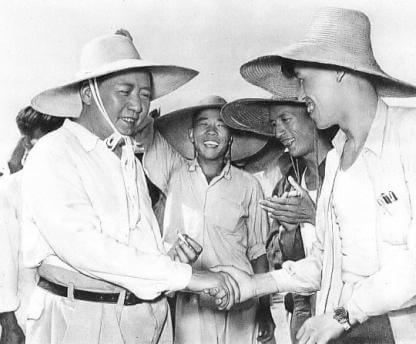 Mao Zedong shakes hands with People's Commune workers in 1959About eighty percent of the Chinese population still lived on the land at that time. In the early and mid-1950s, China had begun to move in incremental steps towards agricultural collectivization. All Chinese peasants had received some land (along with the titles to it) during the phase of the land reform that had ended in the early 1950s. Afterwards, the peasants were initially free to cultivate their land in any way they liked. China's system of agricultural production was therefore constituted out of a widespread body of individual farmers that still relied heavily on manual labour and outdated farming methods. Agricultural yields and productivity were severely limited under such a system. In order to increase food production and productivity, China initiated the formation of small-scale cooperative units which were then incrementally increased in size over a period of several years. The ultimate goal was to establish very large People's Communes some day in the future.
Mao Zedong shakes hands with People's Commune workers in 1959About eighty percent of the Chinese population still lived on the land at that time. In the early and mid-1950s, China had begun to move in incremental steps towards agricultural collectivization. All Chinese peasants had received some land (along with the titles to it) during the phase of the land reform that had ended in the early 1950s. Afterwards, the peasants were initially free to cultivate their land in any way they liked. China's system of agricultural production was therefore constituted out of a widespread body of individual farmers that still relied heavily on manual labour and outdated farming methods. Agricultural yields and productivity were severely limited under such a system. In order to increase food production and productivity, China initiated the formation of small-scale cooperative units which were then incrementally increased in size over a period of several years. The ultimate goal was to establish very large People's Communes some day in the future.
The long and slow process of agricultural collectivization was accompanied by a wide range of measures that were meant to increase productivity: the introduction of small-scale mechanization, improved cultivation methods, cooperation between working groups, shared use of instruments of production (livestock, farm tools etc.) and the use of fertilizers. Altogether, these measures had been successful and well-received by the peasantry. The increase of agricultural yields outpaced the rate of population growth which resulted in an increasing food supply per capita.
 commune members working at night under lamp light in Xinyang county (Henan province) during the Great Leap Forward era
commune members working at night under lamp light in Xinyang county (Henan province) during the Great Leap Forward era
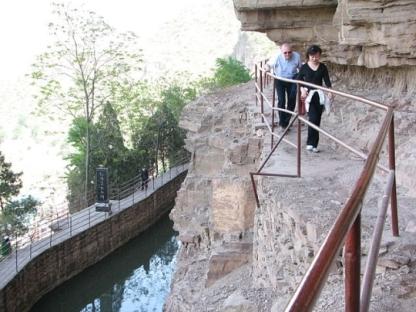 Red Flag Canal at Tigers Mouth Cliff, Henan provinceMao Zedong decided by 1957 to speed up the process of agricultural collectivization and to move along to the final stage, the People's Communes. His initiative to move along to this highest form of collectivization swept across China and marks the beginning of the Great Leap Forward.
Red Flag Canal at Tigers Mouth Cliff, Henan provinceMao Zedong decided by 1957 to speed up the process of agricultural collectivization and to move along to the final stage, the People's Communes. His initiative to move along to this highest form of collectivization swept across China and marks the beginning of the Great Leap Forward.
It included a range of measures that were meant to fully unleash the productive capacity of the Chinese peasantry. Some of these measures were successful. Agricultural collectivization resulted in economies of scale. Large labour projects were initiated that built water reservoirs and irrigation systems.
One example for such a building project that still impresses today is the Red Flag Canal in northern Henan province. Its main channel is 71km long. The total length of the Red Flag Canal is about 1500km if all its branches that distribute water across this arid region are counted.
The most spectacular section of the Red Flag Canal is located about 20km north of Linzhou at the northern tip of Henan province. This section has been designated as the Red Flag Canal Scenic Area (a.k.a. Hongqiqu Scenic Area). Most independent travelers reach this remote place on a day trip by bus from Anyang which lies about 80km away to the southeast. It is therefore advisable to integrate a visit of the Linzhou area with a visit of Anyang and its world-famous Yin Ruins.
Red Flag Canal
The Red Flag Canal is one of the large labour projects that were realized through the mass mobilization of workers during the Great Leap Forward era of the People's Republic of China in the 1960s. The most spectacular section of this canal is the Red Flag Canal Scenic Area (a.k.a. Hongqiqu Scenic Area) which is located about 20km north of the city of Linzhou at the northern tip of Henan province. Here, the Red Flag Canal winds around the side of the rocky Taihang mountains.
Click here to learn more!Opening Hours
Winter: 8am - 6pm
Summer: 8am - 9pm
Entrance Ticket Prices
100 yuan
50 yuan for students, children and the elderly
includes Red Flag Canal Museum, Youth Cave Scenic Spot and Luosi Deep Pool
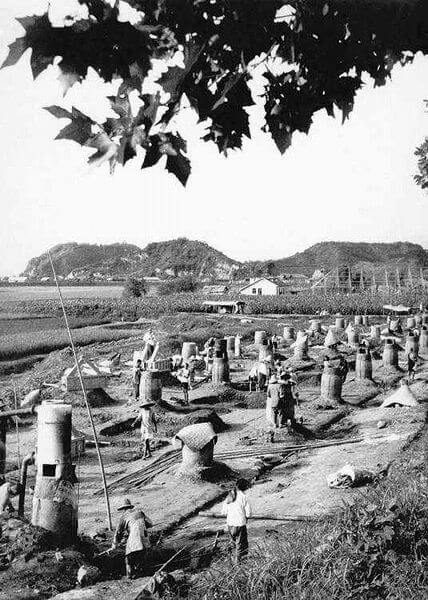 Backyard furnaces that were used to produce steel during the Great Leap Forward eraOther measures were wasteful at best and disastrous at worst, like the effort to mobilize Chinese peasants to contribute to the country's steel production with backyard furnaces. These measures were first implemented in 1957 and that first year was an overwhelming success. Food production increased significantly, though not quite as much in reality as on paper. Overzealous bureaucrats that were in charge of rural areas wanted to make themselves look good (promotion of local leaders was based on results, which is still the case today!) by adding a few percent here and there to the actually achieved results. Based on these falsified reports that the central planners received, various rationing restrictions (China relied heavily on nationally allocated food stamps) were lifted.
Backyard furnaces that were used to produce steel during the Great Leap Forward eraOther measures were wasteful at best and disastrous at worst, like the effort to mobilize Chinese peasants to contribute to the country's steel production with backyard furnaces. These measures were first implemented in 1957 and that first year was an overwhelming success. Food production increased significantly, though not quite as much in reality as on paper. Overzealous bureaucrats that were in charge of rural areas wanted to make themselves look good (promotion of local leaders was based on results, which is still the case today!) by adding a few percent here and there to the actually achieved results. Based on these falsified reports that the central planners received, various rationing restrictions (China relied heavily on nationally allocated food stamps) were lifted.
The resulting increased food consumption in the countryside had the effect that less food (grain and livestock) entered the supply systems of the cities. The central planners then set excessively high production targets for the year 1958. That started to cause serious problems in rural areas. More food was shipped off to the cities, leaving insufficient amounts for consumption in the countryside (since the central planners believed the falsified reports that seemed to indicate that there was plenty of food for both cities and countryside). With the previous rationing restrictions no longer in place, the people in the countryside began to consume stored grains and other foods. Under these conditions, agricultural production couldn't be maintained but declined sharply. Early in 1959, food shortages became commonplace in the countryside, bad weather exacerbated the situation and hunger, malnutrition and eventually starvation followed. Until 1961, between 18 and 45 million people are estimated to have died from starvation!
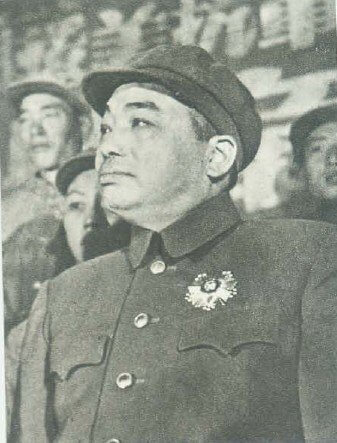 Peng Dehuai in 1950This crisis resulted in the first serious division among the leadership of the Communist Party of China. In July and August of 1959 at the Lushan Conference of the CPC, defence minister Peng Dehuai (1898 - 1974) circulated a letter among the party leadership that criticized Mao Zedong and his agricultural mass movement program. Upon learning of it, Mao Zedong confronted Peng Dehuai and threatened the party leadership with his resignation and possible subsequent efforts to start and lead another peasant revolution! Peng Dehuai was forced to resign as minister of defence. Mao Zedong didn't escape unscathed either. He had to resign from his position as president of the country but remained chairman of the party.
Peng Dehuai in 1950This crisis resulted in the first serious division among the leadership of the Communist Party of China. In July and August of 1959 at the Lushan Conference of the CPC, defence minister Peng Dehuai (1898 - 1974) circulated a letter among the party leadership that criticized Mao Zedong and his agricultural mass movement program. Upon learning of it, Mao Zedong confronted Peng Dehuai and threatened the party leadership with his resignation and possible subsequent efforts to start and lead another peasant revolution! Peng Dehuai was forced to resign as minister of defence. Mao Zedong didn't escape unscathed either. He had to resign from his position as president of the country but remained chairman of the party.
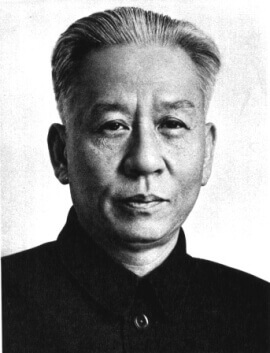 official portrait of Liu ShaoqiLiu Shaoqi (1898 - 1969) replaced Mao as China's president. Liu belonged to a group within the central leadership of the party that came to be known as the pragmatists. The pragmatists controlled China's affairs of state from 1959 until 1962. In the wake of the Great Leap Forward, their emphasis was on setting more realistic economic objectives. Mao's vision of achieving the highest level of agricultural collectivization was no longer on the agenda and the already existing People's Communes were scaled back to smaller scale collectives. Under the pragmatists' rule that was characterized by more concern with economic than political objectives, the party relaxed its oversight over life in the countryside and cities.
official portrait of Liu ShaoqiLiu Shaoqi (1898 - 1969) replaced Mao as China's president. Liu belonged to a group within the central leadership of the party that came to be known as the pragmatists. The pragmatists controlled China's affairs of state from 1959 until 1962. In the wake of the Great Leap Forward, their emphasis was on setting more realistic economic objectives. Mao's vision of achieving the highest level of agricultural collectivization was no longer on the agenda and the already existing People's Communes were scaled back to smaller scale collectives. Under the pragmatists' rule that was characterized by more concern with economic than political objectives, the party relaxed its oversight over life in the countryside and cities.
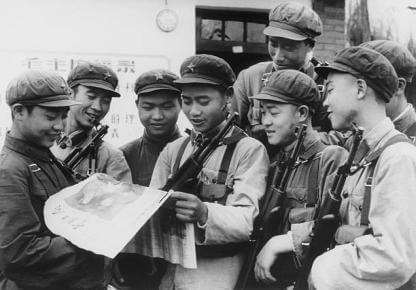 Chinese Red Guards reading a propaganda newspaperBy 1963, Mao Zedong was frustrated with this new emphasis on economics over the political ideals of socialism. As chairman of the party, he started the Socialist Education Movement which was supposed to remind the party leadership of the importance of building socialism. During the time of this campaign, party leaders had to directly experience life and work in the countryside (or city factories to a lesser degree!) for some time. Mao wanted to rekindle the party leaders' passion for the ideals of socialism but his campaign awoke little enthusiasm. The campaign then morphed into another anti-rightist campaign against intellectuals and critics of the party.
Chinese Red Guards reading a propaganda newspaperBy 1963, Mao Zedong was frustrated with this new emphasis on economics over the political ideals of socialism. As chairman of the party, he started the Socialist Education Movement which was supposed to remind the party leadership of the importance of building socialism. During the time of this campaign, party leaders had to directly experience life and work in the countryside (or city factories to a lesser degree!) for some time. Mao wanted to rekindle the party leaders' passion for the ideals of socialism but his campaign awoke little enthusiasm. The campaign then morphed into another anti-rightist campaign against intellectuals and critics of the party.
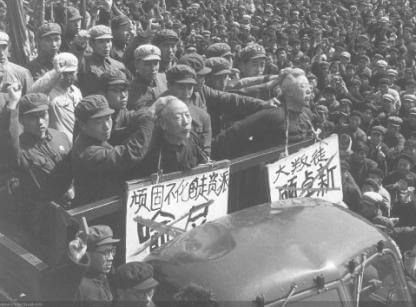 supposed ennemies of socialist China were publicly punished and humiliated during China's Cultural RevolutionBy 1965, Mao Zedong's influence within the party had diminished to such a degree that he had trouble getting his writings published in the official newspaper of the communist party. He left Beijing for Shanghai, where he prepared among the ranks of his supporters to launch the Great Proletarian Cultural Revolution.
supposed ennemies of socialist China were publicly punished and humiliated during China's Cultural RevolutionBy 1965, Mao Zedong's influence within the party had diminished to such a degree that he had trouble getting his writings published in the official newspaper of the communist party. He left Beijing for Shanghai, where he prepared among the ranks of his supporters to launch the Great Proletarian Cultural Revolution.
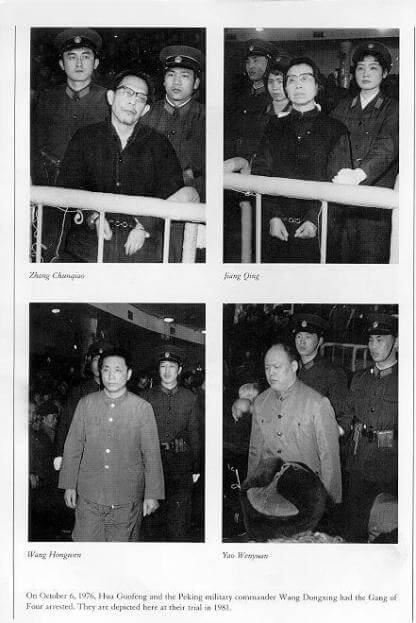 the "Gang of Four" during their trial in 1981. Jiang Qing (top right) was Mao's 4th and last wifeIt was launched in the spring of 1966 and swept across China during the next 2 - 3 years. The broad masses were called upon to criticize the party and to oppose and expose reactionaries within its ranks (famous Mao quote: "attack the headquarters") who had started to take the party along a capitalist road. By that, Mao meant the pragmatists who had emphasized economic development during the preceding years.
the "Gang of Four" during their trial in 1981. Jiang Qing (top right) was Mao's 4th and last wifeIt was launched in the spring of 1966 and swept across China during the next 2 - 3 years. The broad masses were called upon to criticize the party and to oppose and expose reactionaries within its ranks (famous Mao quote: "attack the headquarters") who had started to take the party along a capitalist road. By that, Mao meant the pragmatists who had emphasized economic development during the preceding years.
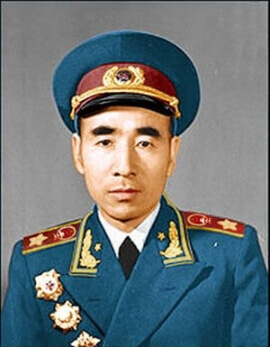 photo of Lin Biao in 1955Late in 1966 and during the first half of 1967, workers in cities all over China founded mass organizations of workers and demanded radical reforms in street demonstrations. In the winter of 1966/1967, popular worker organisations in Shanghai even set aside the leadership of the communist party by dissolving Shanghai's communist party committee (the highest municipal party institution) before establishing the Shanghai Commune in February of 1967! That was a little too radical even for Mao and he ordered the worker organisations to restore the party committee and dissolve the Shanghai Commune. With the power of the party restored, the Cultural Revolution subsequently became a battle to control it.
photo of Lin Biao in 1955Late in 1966 and during the first half of 1967, workers in cities all over China founded mass organizations of workers and demanded radical reforms in street demonstrations. In the winter of 1966/1967, popular worker organisations in Shanghai even set aside the leadership of the communist party by dissolving Shanghai's communist party committee (the highest municipal party institution) before establishing the Shanghai Commune in February of 1967! That was a little too radical even for Mao and he ordered the worker organisations to restore the party committee and dissolve the Shanghai Commune. With the power of the party restored, the Cultural Revolution subsequently became a battle to control it.
That power struggle was decided in April of 1969 at the 9th Party Congress of the CPC. Mao Zedong and his followers within the party that later came to be known as the Gang of Four reestablished their firm control over the party at this congress. That brought the political power struggle within the party to an end, even though the Cultural Revolution nominally continued until Mao's death in 1976.
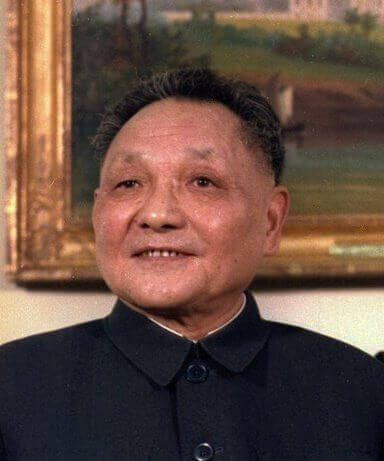 photo of Deng Xiaoping in 1979After 1969, Mao's wing controlled much of the official party propaganda as well as its educational and cultural institutions. Two potential rivals of Mao died in 1969 and 1971. The leader of the pragmatist wing Liu Shaoqi (1898 - 1969) died of natural causes. The death of Lin Biao (1907 - 1971) in a plane crash has a touch of mystery. Supposedly, he was trying to flee China after his involvement in a plot to assassinate Mao had been uncovered!
photo of Deng Xiaoping in 1979After 1969, Mao's wing controlled much of the official party propaganda as well as its educational and cultural institutions. Two potential rivals of Mao died in 1969 and 1971. The leader of the pragmatist wing Liu Shaoqi (1898 - 1969) died of natural causes. The death of Lin Biao (1907 - 1971) in a plane crash has a touch of mystery. Supposedly, he was trying to flee China after his involvement in a plot to assassinate Mao had been uncovered!
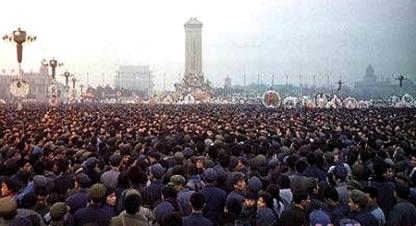 people mourning Zhou Enlai's death on Beijing's Tiananmen Square in April 1976 with the Monument to the People's Heroes in the backgroundDeng Xiaoping (1904 - 1997) had already been an influential figure within the pragmatist wing of the party in the 1950s and early 1960s. Deng returned from a purge (during which time he was forced to work as an ordinary worker at a tractor factory) in the early 1970s and was put in charge of science and technology policy. The conflict over power and policy between the pragmatists and Mao's group continued unabatedly and again came to the forefront after prime minister Zhou Enlai's death in January of 1976.
people mourning Zhou Enlai's death on Beijing's Tiananmen Square in April 1976 with the Monument to the People's Heroes in the backgroundDeng Xiaoping (1904 - 1997) had already been an influential figure within the pragmatist wing of the party in the 1950s and early 1960s. Deng returned from a purge (during which time he was forced to work as an ordinary worker at a tractor factory) in the early 1970s and was put in charge of science and technology policy. The conflict over power and policy between the pragmatists and Mao's group continued unabatedly and again came to the forefront after prime minister Zhou Enlai's death in January of 1976.
The death of this popular leader was widely mourned all across the country. In April of 1976, people in Beijing started to put flowers and other tokens of memory at the foot of the Monument to the People's Heroes on Tiananmen Square.
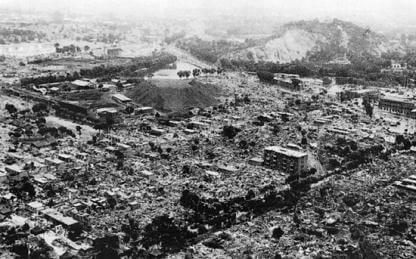 section of Tangshan after the 1976 earthquakeThe Gang of Four interpreted these acts as open criticism of them and their policies which Zhou Enlai had never endorsed. The party leaders had security forces clean the area of all memorabilia on the night between April 4th and 5th 1976. On that second day, it came to open confrontations between the mourners and the security forces that tried to clear the area. Thousands of people were arrested that day. The events of April 1976, now known as the Tiananmen Incident, were the most serious expression of opposition to the existing leadership until then.
section of Tangshan after the 1976 earthquakeThe Gang of Four interpreted these acts as open criticism of them and their policies which Zhou Enlai had never endorsed. The party leaders had security forces clean the area of all memorabilia on the night between April 4th and 5th 1976. On that second day, it came to open confrontations between the mourners and the security forces that tried to clear the area. Thousands of people were arrested that day. The events of April 1976, now known as the Tiananmen Incident, were the most serious expression of opposition to the existing leadership until then.
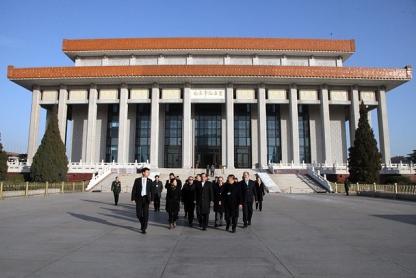 A diplomatic delegation from Ecuador visits the Mao Zedong Mausoleum in November 2013The tumultuous and catastrophic events of 1976 continued on the 28th of July, when an earthquake killed up to 255,000 people in and around Tangshan (northeast of Beijing) and caused substantial damage in the northern parts of China.
A diplomatic delegation from Ecuador visits the Mao Zedong Mausoleum in November 2013The tumultuous and catastrophic events of 1976 continued on the 28th of July, when an earthquake killed up to 255,000 people in and around Tangshan (northeast of Beijing) and caused substantial damage in the northern parts of China.
Zhu De, the founder of the Red Army, died during the same month and Mao Zedong's death on September 9th became the third death of a founding leader of the Chinese communist movement within the same year.
Mao's death became a turning point that the pragmatists within the party seized to move against their opponents. Already in early October 1976, a coalition of pragmatists, conservatives and military leaders came together and had the Gang of Four arrested.
Mao's embalmed body is still on display inside the Mao Zedong Mausoleum on Tiananmen Square. Since the mausoleum is primarily open to the public in the morning, visitors might consider visiting it first early on before moving on to visit the Tiananmen Gate, Forbidden City and Jingshan Park which are all located further north within walking distance.
Mao Zedong Mausoleum
The Mao Zedong Mausoleum is located at the southern part of Tiananmen Square right at the heart of Beijing. Also known as the Memorial Hall of Chairman Mao, this is where the embalmed body of Mao Zedong, the founder and longtime leader of the People's Republic of China, is on display to the public. The Memorial Hall where Mao's body rests inside a crystal coffin that stands on a black granite base is located on the first floor at the center of the mausoleum.
Click here to learn more!Opening Hours
8am - noon
July - August: 7am - 11am
September 9th & December 26th:
8am-11.30am & 2pm-4pm
closed on Mondays
Entrance Ticket Prices
Free Admission
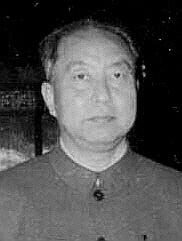 Mao's successor Hua Guofeng during a state visit to RomaniaMao had personally named Hua Guofeng (1921 - 2008) as his successor. However, Hua held the post of Chairman of the CPC Central Committee for only a few years after Mao's death, during which time he didn't pursue any particular vision for China's future. Backstage, the pragmatists manoeuvred to bring Deng Xiaoping back to the top leadership level. With the support of military leaders and technocrats from within the state planning apparatus, Deng Xiaoping became China's Vice Premier which assured the pragmatists' control over policy making. Thereafter, Deng Xiaoping began to carefully and relentlessly reorient China's policies and development strategy.
Mao's successor Hua Guofeng during a state visit to RomaniaMao had personally named Hua Guofeng (1921 - 2008) as his successor. However, Hua held the post of Chairman of the CPC Central Committee for only a few years after Mao's death, during which time he didn't pursue any particular vision for China's future. Backstage, the pragmatists manoeuvred to bring Deng Xiaoping back to the top leadership level. With the support of military leaders and technocrats from within the state planning apparatus, Deng Xiaoping became China's Vice Premier which assured the pragmatists' control over policy making. Thereafter, Deng Xiaoping began to carefully and relentlessly reorient China's policies and development strategy.
The political orientation on socialism made way to a pragmatist approach that emphasized technical expertise to launch China upon a capitalist road of modernization and economic development. A wide variety of measures were put in place to that effect. Family planning policies (more commonly known as the One-Child Policy) were adopted with the goal of keeping China's population growth at least somewhat in check. Collective ownership (particularly in the agricultural sector) was dismantled and new economic opportunities in the private sector were created. The process of opening China to the outside world that had started with the American president Nixon's visit to China in 1972 (still under Mao's reign) was put on the fast track.
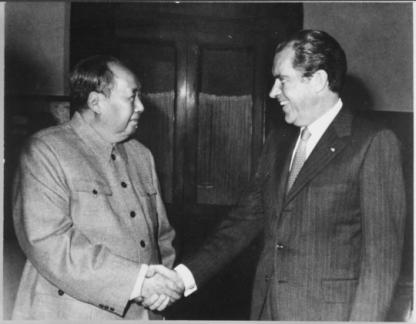 President Nixon's meeting with Mao Zedong in February 1972Under Deng Xiaoping's leadership, direct foreign investment in the Chinese economy began to be encouraged, first in carefully controlled ways. With foreign capital entering the Chinese economy, a boom set in that saw China's economy grow rapidly. The first Special Economic Zones (SEZ) were created in 1980 and especially the development of Shenzhen from a small town near the Hong Kong border to the large metropolis it is today is nothing short of remarkable. Many more Special Economic Zones were created since then and new SEZ's are still being created in our modern times, so for example in Xinjiang's Kashgar in 2010.
President Nixon's meeting with Mao Zedong in February 1972Under Deng Xiaoping's leadership, direct foreign investment in the Chinese economy began to be encouraged, first in carefully controlled ways. With foreign capital entering the Chinese economy, a boom set in that saw China's economy grow rapidly. The first Special Economic Zones (SEZ) were created in 1980 and especially the development of Shenzhen from a small town near the Hong Kong border to the large metropolis it is today is nothing short of remarkable. Many more Special Economic Zones were created since then and new SEZ's are still being created in our modern times, so for example in Xinjiang's Kashgar in 2010.
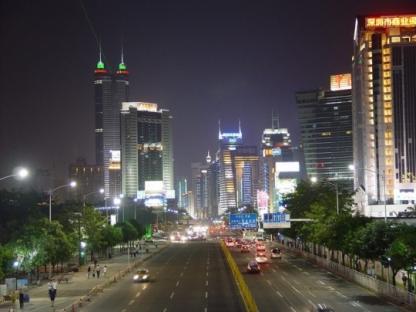 Night view of modern Shenzhen. The metropolis was just a small town a mere 35 years ago.While China started to open up to the outside world, domestic market reforms in the industrial and agricultural sectors were introduced as well. After breaking up the agricultural collectives of Mao's era, the land was distributed to farmers in the form of long-term leases instead of formal ownership. This agricultural reform went hand in hand with a contract system that obliged agricultural households to supply a certain amount of their farming produce to government purchasing units. The farmers were allowed to sell an eventual production surplus (above the contractual amount sold to the government purchasing units) on the private market of the agricultural economy which quickly started to flourish.
Night view of modern Shenzhen. The metropolis was just a small town a mere 35 years ago.While China started to open up to the outside world, domestic market reforms in the industrial and agricultural sectors were introduced as well. After breaking up the agricultural collectives of Mao's era, the land was distributed to farmers in the form of long-term leases instead of formal ownership. This agricultural reform went hand in hand with a contract system that obliged agricultural households to supply a certain amount of their farming produce to government purchasing units. The farmers were allowed to sell an eventual production surplus (above the contractual amount sold to the government purchasing units) on the private market of the agricultural economy which quickly started to flourish.
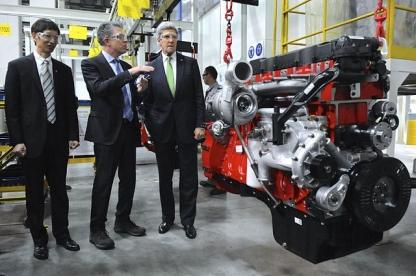 Cummins Vice President Steve Chapman and U.S. Secretary of State John Kerry at the Beijing Foton Cummins Engine Company (BFCEC)Not only the agricultural sector began to grow immensely, but private industrial enterprises (including semi-private enterprises and partnerships with for example townships and/or county governments) became the most dynamic part of China's industrial economy. In the 1980s, more and more joint ventures between Chinese and foreign companies were formed. The state sector of China's industrial economy didn't benefit as much and had to deal with major obstacles on the path to modernization.
Cummins Vice President Steve Chapman and U.S. Secretary of State John Kerry at the Beijing Foton Cummins Engine Company (BFCEC)Not only the agricultural sector began to grow immensely, but private industrial enterprises (including semi-private enterprises and partnerships with for example townships and/or county governments) became the most dynamic part of China's industrial economy. In the 1980s, more and more joint ventures between Chinese and foreign companies were formed. The state sector of China's industrial economy didn't benefit as much and had to deal with major obstacles on the path to modernization.
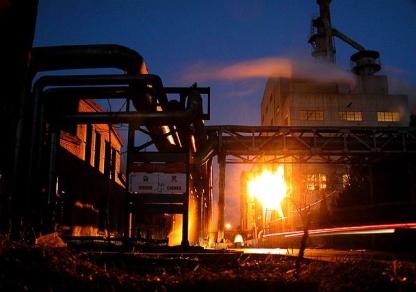 a possibly state-owned factory in Beijing in 2005. Many polluting factories were closed in the run-up to the Beijing Olympics in 2008.
Not only did China's state-owned enterprises employ hundreds of millions of workers, but they also fulfilled quasi-governmental duties by providing retirement pensions as well as services in health and education which weighed heavily on their bottom line. Most state-owned enterprises were hardly profitable at all, but a rapid transformation and cutback of services could have led to public opposition from the side of the workers. Reform of these industrial behemoths was a slow and painstaking process that managed to make some of them competitive, while others stagnated or even went out of business. China's government continued to invest in the state-owned industrial sector of the economy. That helped to raise its profitability slowly but surely. These productivity increases contributed to slowly rising wages of the industrial workers and a higher standard of living.
a possibly state-owned factory in Beijing in 2005. Many polluting factories were closed in the run-up to the Beijing Olympics in 2008.
Not only did China's state-owned enterprises employ hundreds of millions of workers, but they also fulfilled quasi-governmental duties by providing retirement pensions as well as services in health and education which weighed heavily on their bottom line. Most state-owned enterprises were hardly profitable at all, but a rapid transformation and cutback of services could have led to public opposition from the side of the workers. Reform of these industrial behemoths was a slow and painstaking process that managed to make some of them competitive, while others stagnated or even went out of business. China's government continued to invest in the state-owned industrial sector of the economy. That helped to raise its profitability slowly but surely. These productivity increases contributed to slowly rising wages of the industrial workers and a higher standard of living.
The situation of workers in the private sector improved considerably faster than in the state sector though. The losers in China's race to prosperity were at first found in the stagnating public sectors of education and healthcare. Wages as well as working and housing conditions in these sectors didn't improve at first, which made many of these employees feel left out of China's boom (particularly teachers). Frustration and resentment began to grow within some circles of the population while more and more party officials and their offspring reaped outrageous benefits by taking advantage of their positions. Already back then, many Chinese officials had begun to benefit from their legal and illegal partnerships with the private sector of the economy.
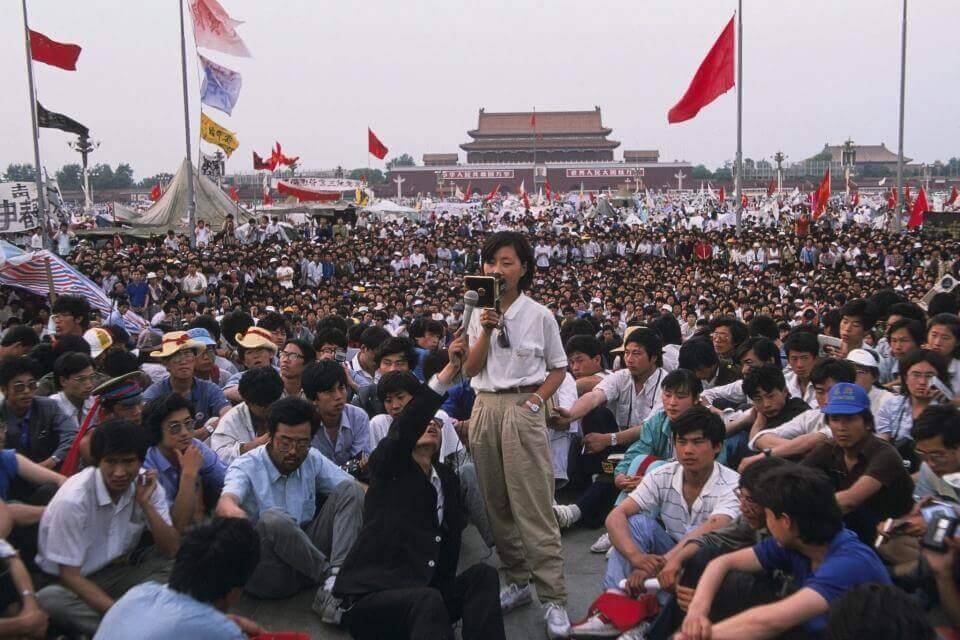 students during the Tiananmen Square protests of 1989
students during the Tiananmen Square protests of 1989
As more and more ordinary Chinese became aware of growing corruption within the government bureaucracy, social tensions began to develop in the 1980s that erupted from time to time in at first small-scale localised demonstrations of protest. Some of these protests erupted in a sort of proxy way in the form of anti-Japanese protests, whereas other demonstrations directly targeted the party leadership. A reform wing within the party emerged that advocated for even more rapid reforms in conjunction with liberalization policies and more direct participation of the people.
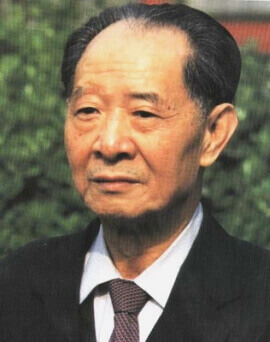 photo of Hu YaobangOne of these reformers was Hu Yaobang (1915 - 1989) who was widely popular among the masses at this time. His death in April 1989 became the spark for the student protests and mass demonstrations of the following weeks (now known as the Tiananmen Square Protests of 1989). Similar to the events after Zhou Enlai's death in 1976, people expressed their mourning in conjunction with demands for more reform and liberalization. Large groups of students and other dissatisfied parts of the population began to assemble and demonstrate on Beijing's Tiananmen Square.
photo of Hu YaobangOne of these reformers was Hu Yaobang (1915 - 1989) who was widely popular among the masses at this time. His death in April 1989 became the spark for the student protests and mass demonstrations of the following weeks (now known as the Tiananmen Square Protests of 1989). Similar to the events after Zhou Enlai's death in 1976, people expressed their mourning in conjunction with demands for more reform and liberalization. Large groups of students and other dissatisfied parts of the population began to assemble and demonstrate on Beijing's Tiananmen Square.
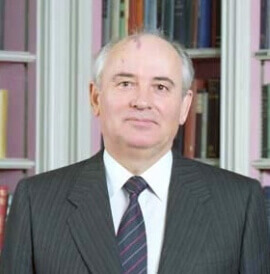 Mikhail Gorbachev in 1987These demonstrations had already grown substantially in size by the time Mikhail Gorbachev, the popular leader and reformer of the Soviet Union, came to visit Beijing in mid-May 1989. China's leaders debated possible courses of action against the student protests (for example whether to impose martial law) which made their internal division become apparent. Whereas some leaders supported the students' call for new reforms, others saw them as unpatriotic and anti-revolutionary. The Western media reported about the protests as a sign for the impending overthrow of the Chinese government and collapse of the rule of the CPC.
Mikhail Gorbachev in 1987These demonstrations had already grown substantially in size by the time Mikhail Gorbachev, the popular leader and reformer of the Soviet Union, came to visit Beijing in mid-May 1989. China's leaders debated possible courses of action against the student protests (for example whether to impose martial law) which made their internal division become apparent. Whereas some leaders supported the students' call for new reforms, others saw them as unpatriotic and anti-revolutionary. The Western media reported about the protests as a sign for the impending overthrow of the Chinese government and collapse of the rule of the CPC.
Ultimately, it was Deng Xiaoping's decision to have the protests suppressed, by force if necessary. Upon his order, the Chinese People's Liberation Army started to move into Beijing from both east and west on June 4th 1989. Hundreds of people (perhaps even thousands) were killed in the street fighting that ensued. (The exact number of casualties of the Tiananmen Square Massacre is unknown since China's leadership never published official numbers.) During the early morning hours of June 5th, an agreement was reached between the two sides that allowed the remaining students to leave Tiananmen Square unharmed. Many of them were nevertheless arrested during the days that followed but some managed to escape from China. With Beijing under a state of martial law, the protest movement of 1989 came to an end.
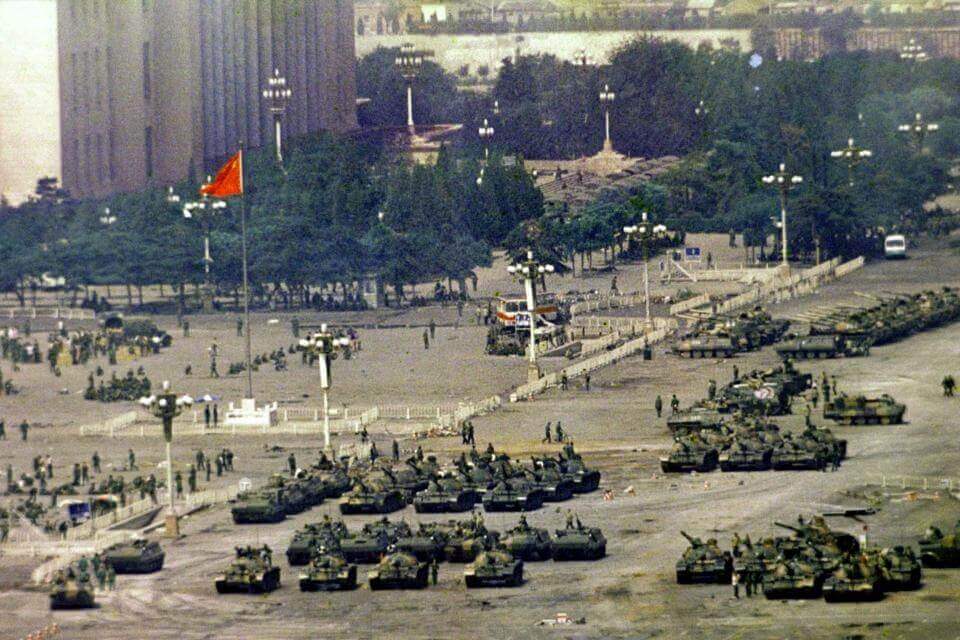 tanks of the People's Liberation Army on Tiananmen Square in 1989
tanks of the People's Liberation Army on Tiananmen Square in 1989
Chinese History Digest's illustrated overview of China's history ends here for now.
